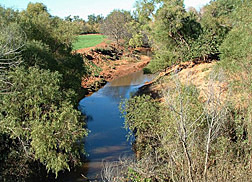Water Quality in Oklahoma
Observations, Obstacles, and Opportunities
|
|
ARS experts have been studying soil and water conservation in Oklahoma’s Little Washita River Experimental Watershed—one of the largest and best monitored experimental watersheds—for decades. Now they are expanding their research to better understand the effects of agricultural conservation practices on water quality in this part of the world.
Soil scientist Jean Steiner is the director of the ARS Grazinglands Research Laboratory in El Reno, Oklahoma. She is part of a team assessing environmental changes in watersheds where agricultural practices are shifting from intensive tillage to conservation tillage and other conservation practices. Other ARS project members include soil scientist Patrick Starks, geologist John Daniel, hydraulic engineer Jurgen Garbrecht, hydrologist Daniel Moriasi, and ecologist Sherwood McIntyre.
The Little Washita Watershed—part of the national Conservation Effects Assessment Project watershed network—covers 236 square miles of gently rolling hills, with a mix of cropland, forests, and grazinglands. The study area was expanded in 2004 to include the 304-square-mile watershed above Fort Cobb Reservoir.
Throughout the study area, a network of instruments and stream gauges are used to monitor weather and runoff. The team collects water samples to track surface-water and groundwater variables. Scientists also collect soil samples, farm-management surveys, and land-use and land-cover information.
As part of their analysis, the ARS scientists found that during a 55-year period, average annual precipitation in multiyear wet periods was 33 percent higher than precipitation during multiyear dry periods. These significant variations in the watershed’s climate patterns greatly affected hydrological and other environmental processes. Runoff during the wet intervals was more than 100 percent higher than during dry periods, and suspended sediment in the streams increased more than 180 percent.
These results strongly suggest that the effects of agricultural conservation practices must be analyzed within the context of persistent, multiyear variations in precipitation and other landscape dynamics. For instance, phosphorus levels in streams are linked to several factors, including area, slope, stream density, and channel stability. In addition, the effects of soil water content, precipitation amount, and precipitation intensity on runoff and solute transport must be identified.
If these factors—and many others like them—are not distinguished from the effects of land-management practices, the results of conservation efforts could easily be masked.
“We need to focus on locating the sources of sediment and measuring the storage and rate of movement of sediments and nutrients within watersheds,” Steiner says. “We want to use our findings to develop new approaches for mitigating water-quality problems and new tools that will help us determine the best placement for conservation practices to improve water quality.”—By Ann Perry, Agricultural Research Service Information Staff.
This research is part of Water Availability and Watershed Management, an ARS national program (#211) described on the World Wide Web at www.nps.ars.usda.gov.
Jean Steiner is with the USDA-ARS Grazinglands Research Laboratory, 7207 W. Cheyenne St., El Reno, OK 73036; phone (405) 262-5291, fax (405) 262-0133.
"Water Quality in Oklahoma" was published in the January 2009 issue of Agricultural Research magazine.







